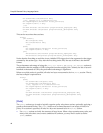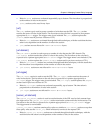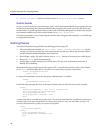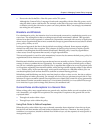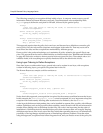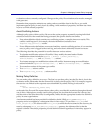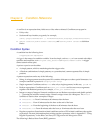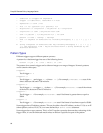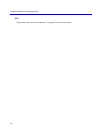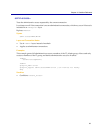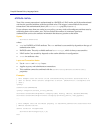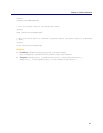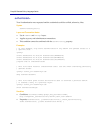
Chapter 3: Condition Reference
A condition is an expression that yields true or false when evaluated. Conditions can appear in:
• Policy rules.
• Section and layer headers, as guards; for example,
[Rule] group=(“bankabc\hr” || “cn=humanresources,ou=groups,o=westernnational”)
• define condition, define domain condition, and define prefix condition definition
blocks.
Condition Syntax
A condition has the following form:
trigger=pattern-expression
A trigger is the name of a condition variable. It can be simple, such as url, or it can contain sub-object
specifiers and modifiers, as in
url.path.case_sensitive or request.header.Cookie.A trigger
cannot contain white space.
A pattern expression can be either:
• A simple pattern, which is matched against the trigger value.
• A Boolean combination of simple patterns, or a parenthesized, comma-separated list of simple
patterns.
A pattern expression can be any of the following:
• String: A string argument must be quoted if it contains whitespace or other special characters. An
example condition expression is
category=”self help”.
• Single argument: Conditions such as
live= take only a single argument, in this case, yes or no.
• Boolean expressions: Conditions such as
server_url.scheme= can list one or more arguments
together with Boolean operators; for example,
server_url.scheme=!http.
• Integer or range of integers: Numeric conditions can use Boolean expressions and double periods
(
..), meaning an inclusive numeric range. Numeric ranges cannot use whitespace. The minute=
condition is used to show examples of ranges:
❐ minute=10..40—From 10 minutes to 40 minutes after the hour.
❐ minute=10..—From 10 minutes after the hour to the end of the hour.
❐ minute=..40—From the beginning of the hour to 40 minutes after the hour.
❐ minute=40..10—From 40 minutes after the hour, to 10 minutes after the next hour.
• Regular expressions: Some header-related conditions and two URL-related conditions take regular
expressions. For more information about writing regular expressions, refer to Appendix E: “Using
Regular Expressions,” in the Blue Coat ProxySG Configuration and Management Guide.
The following is Backus-Naur Form (BNF) grammar:




